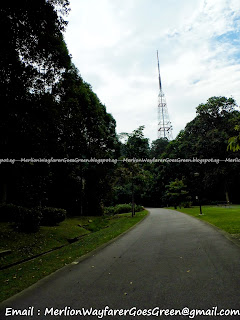Bukit Batok Nature Park
Central, Singapore
May 2013
Near a footpath at the Bukit Batok Nature Park where she met
"The Laughing Zorro Bird", Merlion Wayfarer noticed a colony of Oecophylla Smaragdina (Weaver Ants) building a nest among some shrubs. These are the commonly-termed "red ants" that inhabit trees and bushes, move around a lot, and tend to crawl into your footwear and inflict painful bites.
(There are lots of ants here, so do make sure you are wearing long pants with proper shoes and socks when you explore this park.)
The weaver ant's ability to build capacious nests from living leaves has undeniably contributed to their ecological success. The initial phase in nest construction involves workers surveying potential nesting leaves by pulling on the edges with their mandibles. When a few ants have successfully bent a leaf onto itself or drawn its edge toward another, other workers join in the effort. The probability of a worker joining the concerted effort is dependent on the size of the group, with workers showing a higher probability of joining when the group size is large.
When the span between two leaves is beyond the reach of a single ant, workers form chains with their bodies by grasping one another's petiole (waist). Multiple intricate chains working in unison are often used to ratchet together large leaves during nest construction. Once the edges of the leaves are drawn together, other workers retrieve larvae from existing nests using their mandibles. These workers hold and manipulate the larvae in such a way that causes them to excrete silk. They can only produce so much silk, so the larva will have to pupate without a cocoon. The workers then maneuver between the leaves in a highly coordinated fashion to bind them together.
Weaver ants' nests are usually elliptical in shape and range in size from a single small leaf folded and bound onto itself to large nests consisting of many leaves and measure over half a meter in length. The time required to construct a nest varies depending on the leaf type and eventual size, but often a large nest can be built in significantly fewer than 24 hours. Although weaver ants' nests are strong and impermeable to water, new nests are continually being built by workers in large colonies to replace old dying nests and those damaged by storms.
The full albums are available at:
Sources
- "Dynamics of aggregation and emergence of cooperation" by DENEUBOURG, J.L., Lioni, A. & DETRAIN, C. (2002). Biological Bulletin 202:262-267.
- "The ants" by HOLLDOBER, B. & WILSON, E.O. (1990). Harvard University Press, Cambridge, Massachusetts.

































